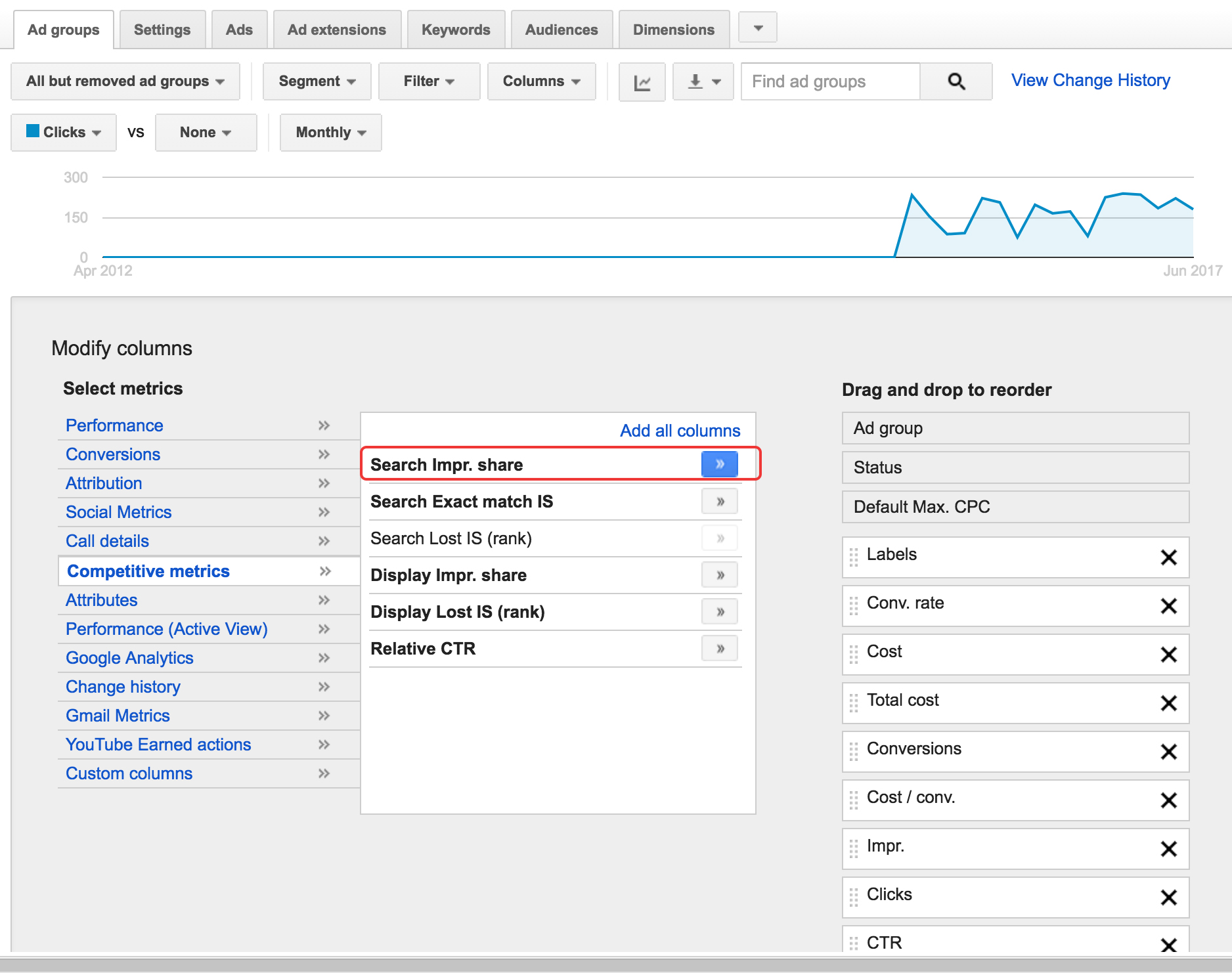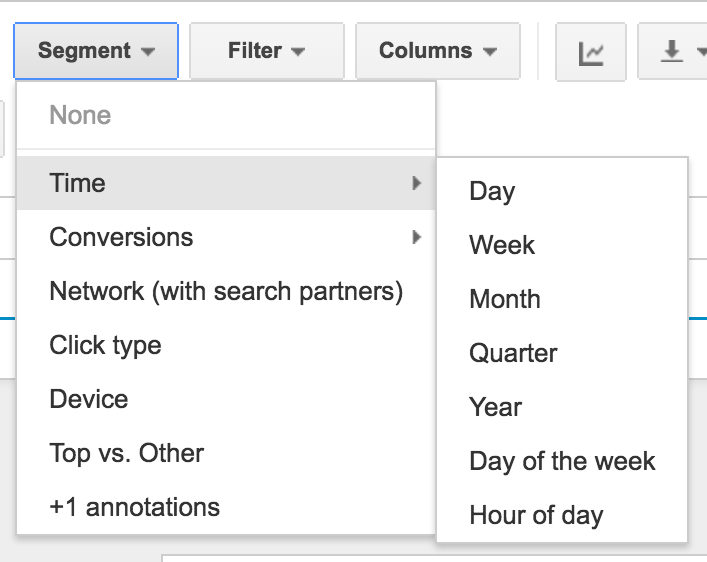Once you’ve set up your account, campaigns, adgroups, ads and keywords you will need to regularly review your account performance.
You will obviously have decided from the start how you want it to perform: growth (increase the number of visitors to your website), profitability or break even. If for instance you’re running an ecommerce website your end result will probably be easier to calculate.
Once you’ve added the conversion tag to your confirmation page you can quickly check if your cost per conversion is below the price you’re selling your products. However don’t forget about the long term value of a customer which means you could afford a higher cost of acquisition than the price tag as you will be able to upsell some other products to these customers in the long term.
For any other type of businesses the first step is to determine the average value of a lead. What’s your usual conversion rate from lead to customer? What’s the short and long term value of a customer? What’s the lifetime value of a customer? Once you have calculated these you are ready to start optimising your campaigns
1. Check the competition regularly
If you have not decreased your bids and notice your average position is lower than it used to be, it’s highly probable there are new businesses advertising for your keywords. Simply go to Google and type your keywords to see who are those new competitors. Check their website and landing pages and what they have to offer and see if you could do better.
Once you know about those competitors you will have 2 options: increase your bids to regain your position or stay behind and rework your ads with a stronger call to action. No matter what you decide to do, it is still vital for your business to keep aware of the competition and adapt your offer if necessary.
2. Keep only your best performing ads
You should always have at least 3 different ads running in rotation at the same time. Check their metrics every month and according to what you want to achieve, keep the best one and create 2 new ones. This will allow you to narrow down what works best for you.
3. Keep an eye open for new keywords
Check regularly if there are new keywords you could add to your campaigns: use the search terms feature in Adwords, go check your competitors’ websites from time to time, subscribe to newsletters about your industry to keep up to date with the latest trends. Also remember to add your new products and services to your campaigns as soon as they’re released.
4. Keep an eye open for new negative keywords
Once again the search term feature will be particularly useful to help you find new negative keywords. Simply export your list of search terms to Excel and look for new irrelevant keywords.
5. Pause keywords with no clicks or impressions
After a few weeks or months, you should delete or pause keywords that did not get any click or impression. Some people will be reluctant to do this as most of the time these are long tail keywords. Their argument will be that the number of impressions was always supposed to be low for those and even though they may not get a click for months, the first one could lead to a sale.
Nothing wrong with this view except Google does not like accounts and campaigns with a low CTR and once again this will be taken into account for your quality score. So don’t think twice, just remove them.
6. Check your impression share
Impression share is a metric in Google Adwords that will show you how many impressions you’re missing
 out on in your campaigns. A low percentage means you have room to boost the showing of your ads.
out on in your campaigns. A low percentage means you have room to boost the showing of your ads.
These may not show as often as they could for various reasons: a daily budget that is too low – meaning it’s depleted early in the day, some important keywords that are missing or have a match type that is too restrictive (too many exact matches for example), a setting in your campaigns that only allows your ads to show at a certain time of the day or simply that your keywords have a low quality score or bid.
There are some other metrics available that can help you refine your analysis:
- Search exact match IS: this will give you the number of impressions you’ve received for exact matches of your keywords divided by the total number of impressions you could have received.
- Search Lost IS (rank): these are the number of impressions you missed due to a poor quality score
- Search Lost impression share (budget): this is the number of impressions you missed because of a low daily budget.
You can also get those same metrics for the Display Network. To add these features to your campaigns, select Columns/Customise Columns/Competitive Metrics then add the ones you want. Those metrics need to be looked at with caution: having a low impression share is not necessarily a bad thing if you’re getting the right targeted traffic and conversions on your website. They need to be taken as what it is – a metric to help you detect any potential problem.
7. Isolate high performing keywords
After a few weeks of running your campaigns you will probably notice that some keywords seem to perform better than others. Isolating them in their own adgroup will allow you to have an even more refined ad, budget and bid and increase the showing of your ads for these. In addition you will be able to test different match types for these high performance keywords.
8. A/B testing on new landing pages
Improving your conversion rates is key to great profits in Adwords. So you should constantly try to improve your landing pages through A/B testing. Adwords gives you the opportunity to run several variations of the same ads so use this to test all sort of things: colour, design, shorter forms, different pictures, etc.
Just remember to run those tests step by step: only one change at a time. And do keep a chart of those changes so you can always revert back to the previous version if something goes wrong.
9. Check the performance of your segments
Adwords can give you stats for a lot of different segments. You can check how your campaigns perform at 
different times of the day or according to the device people are using when viewing your ads (computers, smartphones or tablets). This last feature could illustrate that your website is not user friendly enough on a mobile with a full browser.
It may result in the decision to build a mobile version of your site or simply to stop your ads from showing on these devices. Click Type will show you where people clicked on your ad. This is particularly useful if you’re using sitelinks for example (deep links to specific parts of your website showing at the bottom of your ad): it will allow you to check if this feature seems to work for you or not.
10. Try the conversion optimiser
Are you struggling with your ROI? Did you figure out what your cost of acquisition should be? Then try the conversion optimiser. As explained earlier there is no guarantee it will work for your activity but it’s definitely worth testing.
11. Use change history
Change history is another great feature available in Adwords. It allows you to check all the changes you’ve made to your campaigns over any period of time. It means you don’t need to keep a record of these in a separate spreadsheet anymore. if something goes wrong with a particular campaign or adgroup that’s the first thing you need to check.
You will be able to view all the changes you’ve made to a keyword, including new bids, match type, etc. So if you can’t figure out what goes wrong with a campaign, simply revert back to a time when you were happy with its performance.
12. Ad position
Appearing on top of the search results is not necessarily a good thing. This is the first ad people will click, which means you will get a lot of clicks and spend a lot of money for a low conversion rate. From experience being in third or second position in the search results is usually a good compromise to receive a decent amount of clicks and conversion rate. Run the test over a few days then check for yourself.


